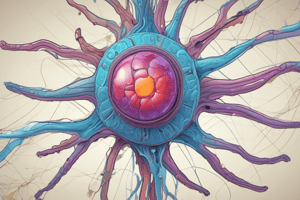Podcast
Questions and Answers
Which of the following correctly describes the role of myelin in the nervous system?
Which of the following correctly describes the role of myelin in the nervous system?
- Myelin supports neuronal cell bodies.
- Myelin prevents the leakage of neurotransmitters.
- Myelin increases the speed of action potentials. (correct)
- Myelin conducts electrical signals to muscle cells.
What distinguishes the three types of muscle tissues in terms of structure?
What distinguishes the three types of muscle tissues in terms of structure?
- Smooth muscle is striated and involuntary.
- Cardiac muscle is voluntary and non-striated.
- Skeletal muscle is voluntary and striated. (correct)
- Skeletal muscle is involuntary and striated.
Which statement accurately characterizes negative feedback in the context of homeostasis?
Which statement accurately characterizes negative feedback in the context of homeostasis?
- It amplifies the deviation from a set point.
- It consistently initiates a response to increase a physiological measure.
- It has no impact on maintaining homeostasis.
- It reduces the intensity of a physiological response. (correct)
In which part of the neuron does the action potential begin?
In which part of the neuron does the action potential begin?
What is the primary function of the cranial meninges?
What is the primary function of the cranial meninges?
How does the autonomic nervous system differ from the somatic nervous system?
How does the autonomic nervous system differ from the somatic nervous system?
Which of the following is a primary function of enzymes in biological processes?
Which of the following is a primary function of enzymes in biological processes?
Which statement about epithelial tissues is correct?
Which statement about epithelial tissues is correct?
Flashcards
Homeostasis
Homeostasis
The body's ability to maintain a stable internal environment despite external changes.
Dehydration Synthesis
Dehydration Synthesis
A chemical reaction where monomers join to form polymers, releasing a water molecule.
Roles of Organelles
Roles of Organelles
Each organelle has a specialized function, working together to maintain cell structure and function.
Epithelial Tissue
Epithelial Tissue
Signup and view all the flashcards
Neuron Anatomy
Neuron Anatomy
Signup and view all the flashcards
Resting Potential
Resting Potential
Signup and view all the flashcards
Major Brain Regions
Major Brain Regions
Signup and view all the flashcards
Sensory Receptors
Sensory Receptors
Signup and view all the flashcards
Study Notes
BIOL 109 Final Exam Study Guide
- Format: 2-hour cumulative exam, 15% of final grade, 75 multiple-choice questions. Focus on lecture material. Lab experience may be helpful.
- Lecture Topics:
- Introduction: Anatomy & physiology, directional terms, body cavities, homeostasis, positive and negative feedback.
- Chemical Level of Organization: Dehydration synthesis, hydrolysis, pH, organic macromolecules, and enzymes.
- Cellular Level of Organization: Organelles, membrane transport, cell cycle, mitosis.
- Tissue Level of Organization: Epithelial types, muscle tissues, connective tissues, membranes.
- Integumentary System: Skin layers, accessory structures.
- Nervous Tissue/Electrophysiology: Nervous system terminology, neuron types, myelin, neuroglia, resting potential, depolarization, hyperpolarization, action potential propagation.
- Brain/Cranial Nerves: Brain anatomy, cortical regions, diencephalon, midbrain, brainstem, cerebellum, cranial meninges, cranial nerves (excluding glossopharyngeal, accessory, and hypoglossal).
- Spine/Spinal Nerves: Spinal cord anatomy, sensory and motor functions, nerve plexuses, peripheral nerves, sensory receptors, reflex mechanisms.
- Autonomic Nervous System: Autonomic vs. somatic systems, parasympathetic vs. sympathetic divisions, neurotransmitters, receptors (nicotinic, adrenergic), dual innervation.
- Special Senses: Anatomy/physiology of olfaction, gustation, vision, hearing.
- Endocrine System: Major hormones, second messengers, release mechanisms.
- Bones and Osseous Tissue: Anatomy, endochondral vs. intramembranous ossification.
- Articulations: Joint movements (flexion, extension, etc.)
- Muscle Tissue: Muscle cell (fiber) anatomy, connective tissue layers, muscle contraction stages (excitation, coupling, cross-bridge cycle).
Note:
- Lecture order differs from textbook order for topics 7 and 8.
- Use textbook reading references for guidance.
Studying That Suits You
Use AI to generate personalized quizzes and flashcards to suit your learning preferences.




